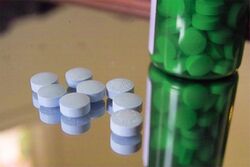Chemistry:Fioricet
| Combination of | |
|---|---|
| Butalbital | Barbiturate |
| Acetaminophen | Miscellaneous Analgesic |
| Caffeine | Xanthine |
| Clinical data | |
| Trade names | Fioricet |
| AHFS/Drugs.com | fioricet |
| Pregnancy category |
|
| Routes of administration | Oral |
| Legal status | |
| Legal status |
|
| Identifiers | |
| ChemSpider |
|
Fioricet is a brand name for a medication formulated with a combination of the barbiturate butalbital, the analgesic and antipyretic acetaminophen, and the vasoconstrictive xanthine caffeine.[citation needed] Approved for the treatment of tension headaches, muscle contraction headaches, and post-dural puncture headaches,[citation needed] it is also commonly prescribed off label for migraine headaches, although chronic use has been known to known to cause rebound migraines.[citation needed]
Medical uses
Fioricet is indicated for the treatment of tension headaches. It is also commonly prescribed for migraines, although it is not approved by the FDA for this use in the United States. The usual adult dose is one to two tablets every four hours as needed, not to exceed six tablets in a twenty-four-hour period.[1][2]
Side effects
Commonly reported side effects include euphoria, dizziness or lightheadedness, drowsiness or sedation, intoxication, nausea, vomiting, dependence, shortness of breath, and abdominal pain.[citation needed]
Prolonged use can cause rebound headaches.[3]
Rarely, use of barbiturates can lead to Stevens–Johnson syndrome.[citation needed]
Overdose
Butalbital exerts its toxicity through excessive sedation, resulting in respiratory depression and ultimately death via hypoxia. Nonlethal overdoses may also result in coma and death. There is no specific antidote to barbiturate overdose; treatment is supportive, generally including the administration of intravenous saline, naloxone, thiamine, glucose, sodium bicarbonate to alkalize the urine and increase rate of excretion, and activated charcoal via nasogastric tube.[citation needed]
Acetaminophen exerts its toxicity through the production of a toxic metabolite that can cause liver damage at doses as low as four grams. Larger doses can precipitate acute liver failure, acute kidney injury, or gastrointestinal bleeding; death has been known to occur with ingestion of ten to fifteen grams. The specific antidote to acetaminophen overdose is N-acetylcysteine.[citation needed]
Mechanism of action
Butalbital exerts a generalized depressant effect on the central nervous system and, in very high doses, has peripheral effects.[citation needed] Acetaminophen has analgesic and antipyretic effects mediated by a metabolite that acts at cannabinoid receptors.[dubious ][citation needed] Caffeine is thought to produce constriction of cerebral blood vessels and serves to counteract the sedative effect of butalbital.[citation needed]
Butalbital has a half-life of about 35 hours. Acetaminophen has a half-life of about 1.25 to 3 hours, but may be increased by liver damage and after an overdose. Caffeine has a half-life of about 2.5 to 4.5 hours.[4]
Formulation
Fiorcet historically contained 50 mg of butalbital, 40 mg of caffeine, and 325 mg of acetaminophen per dose. However, in accordance with FDA guidelines advising manufacturers to limit doses of acetaminophen in prescription drugs,[5] the acetaminophen content was lowered to 300 mg as of 2014.[6][7]
Fioricet is also available in a formulation containing 30 mg of codeine per dose.[8]
References
- ↑ Fioricet at RxList
- ↑ http://dailymed.nlm.nih.gov/dailymed/archives/fdaDrugInfo.cfm?archiveid=4417
- ↑ A Hidden Cause of Headache Pain - New York Times
- ↑ https://examine.com/supplements/caffeine/#summary2-7
- ↑ Food and Drug Administration. FDA drug safety communication: prescription acetaminophen products to be limited to 325 mg per dosage unit; boxed warning will highlight potential for severe liver failure.
- ↑ (Old formulation) Fioricet package insert, Cardinal Health, Inc.
- ↑ (New formulation) Fioricet package insert, Watson Pharma, Inc.
- ↑ Fioricet with codeine capsule package insert, Watson Pharma, Inc
External links
- Fioricet - drugs.com
- Fiorinal & Fioricet - National Headache Foundation


